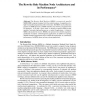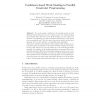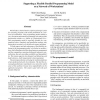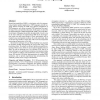1024 search results - page 35 / 205 » Complexity and Performance in Parallel Programming Languages |
PLDI
2009
ACM
14 years 3 months ago
2009
ACM
Multicore designs have emerged as the mainstream design paradigm for the microprocessor industry. Unfortunately, providing multiple cores does not directly translate into performa...
CONPAR
1994
14 years 23 days ago
1994
The Rewrite Rule Machine (RRM) is a massively parallel MIMD/SIMD computer designed with the explicit purpose of supporting veryhigh-level parallel programming with rewrite rules. T...
CP
2009
Springer
14 years 9 months ago
2009
Springer
The most popular architecture for parallel search is work stealing: threads that have run out of work (nodes to be searched) steal from threads that still have work. Work stealing ...
ICDCS
1996
IEEE
14 years 25 days ago
1996
IEEE
We introduce a shared memory software prototype system for executing programs with nested parallelism on a network of workstations. This programming model exhibits a very convenie...
ICFP
2010
ACM
13 years 9 months ago
2010
ACM
Nested data-parallelism (NDP) is a declarative style for programming irregular parallel applications. NDP languages provide language features favoring the NDP style, efficient com...




